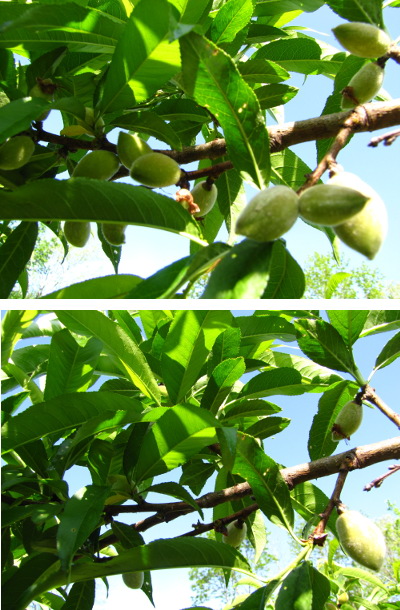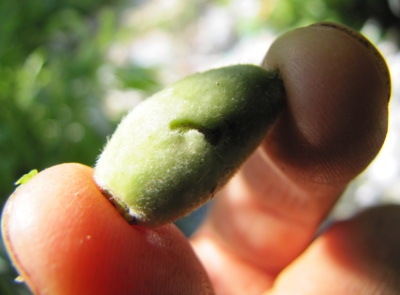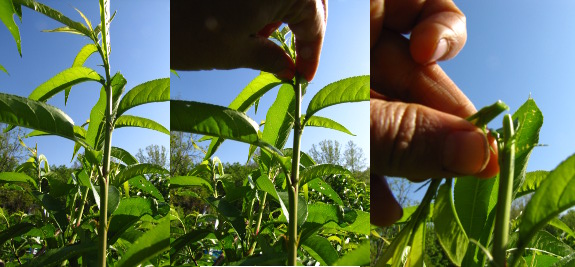
Thinning peaches and pinching watersprouts
 Thinning
is like editing. The process is time-consuming and mentally
difficult, but if you bite the bullet and do the hard work, the fruits
of your labor are twice as good.
Thinning
is like editing. The process is time-consuming and mentally
difficult, but if you bite the bullet and do the hard work, the fruits
of your labor are twice as good.
Last year, I thinned
our peaches hesitantly,
leery of removing so many
baby fruits, but my work paid off in spades. In fact, as I picked
our huge, delicious peaches that summer, I only wished I'd thinned a
little harder since the peaches that had been left close together were
of much lower quality. And despite what you might think, the big
fruits had every bit as much flavor as you'll find in the tiny peaches
on abandoned trees that never get thinned. (I also feel obliged
to add my father's experience --- he didn't thin his peaches last year
and one tree bore so heavily that branches broke all the way off!)
 So
this year, I thinned hard, removing about seven peaches for each one I
left behind. In addition to making sure the
fruits were separated by several inches along the branch, I tried to
select for large, unblemished fruits in sunnier spots. I could
tell that the oriental
fruit moth had
already laid its eggs, so I did my best to remove the infested
fruits. (No, I never did get around to implementing any control
strategies for this pest, so I'm sure I'll be scooping out wormy
centers this summer.) The tree will probably drop a few more of
fruits in a week or two, but last year I had no problem with pruning
pre-drop, and even this "hard" thinning job isn't as extreme as most
peach experts suggest.
So
this year, I thinned hard, removing about seven peaches for each one I
left behind. In addition to making sure the
fruits were separated by several inches along the branch, I tried to
select for large, unblemished fruits in sunnier spots. I could
tell that the oriental
fruit moth had
already laid its eggs, so I did my best to remove the infested
fruits. (No, I never did get around to implementing any control
strategies for this pest, so I'm sure I'll be scooping out wormy
centers this summer.) The tree will probably drop a few more of
fruits in a week or two, but last year I had no problem with pruning
pre-drop, and even this "hard" thinning job isn't as extreme as most
peach experts suggest.

Meanwhile, I went ahead
and snapped the tops off watersprouts popping
up in the center of the tree. Peach trees pruned to the open
center system will
keep putting up watersprouts every year, and if you
leave them alone, you'll be wasting a lot of your tree's energy that
could go into building useful branches instead of toward branches that
are just going to be lopped off. Meanwhile, the watersprouts
shade the fruits, negating the purpose of the open center system
(opening up as much of the fruit zone as possible to the sun.)
I'll try to remember to come back and do another round of summer
pruning later and to
remove any twigs that wilt (signs of further oriental fruit moth
damage.) But, mostly, I'll just sit back and watch the fuzzy
fruits swell outside the kitchen window.
Want more in-depth information? Browse through our books.
Or explore more posts by date or by subject.
About us: Anna Hess and Mark Hamilton spent over a decade living self-sufficiently in the mountains of Virginia before moving north to start over from scratch in the foothills of Ohio. They've experimented with permaculture, no-till gardening, trailersteading, home-based microbusinesses and much more, writing about their adventures in both blogs and books.
Want to be notified when new comments are posted on this page? Click on the RSS button after you add a comment to subscribe to the comment feed, or simply check the box beside "email replies to me" while writing your comment.
